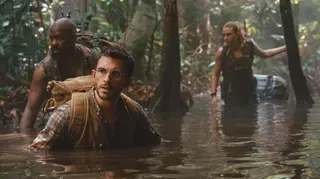May 28, 2021
The Old and the New at Rebuilt LaGuardia Airport
Craig Ruttle READ TIME: 2 MIN.
A multibillion dollar makeover of New York City's LaGuardia Airport isn't completely wiping away the airport's storied past.
Quietly functioning on the nearly 700 acres of the evolving transport hub are some of the oldest continuously operating airport facilities in the U.S.
Just west of the gleaming hull of the airport's new Terminal B stand two American Airlines airplane hangars that date back more than 70 years, to the earliest days of civil aviation and the advent of cross-country flights.
Farther west are Hangar 7 and the Marine Air Terminal, known as Terminal A, where terra cotta flying fish symbolize the Boeing 314 Clipper flying boats that skimmed across nearby Bowery Bay in 1939.
Hangar 7, once a facility for the flying boats, now houses snow removal equipment. The Marine Air Terminal continues to serve passengers, and the hangers are being upgraded and will continue to serve as an aircraft maintenance facility.
Those old facilities might be noticed by relatively few of the passengers returning to LaGuardia after the pandemic downturn.
The airport is in the midst of an $8 billion modernization effort that involves constructing 72 gates and two new main terminals to replace notoriously cramped corridors and ticketing areas. The work has been done even as flights continue to come and go.
It has been a swirl of construction activity for years, but the new facility has gradually emerged, in some places decorated with art and an indoor fountain that resembles a continuous light show.
Beyond the steel and glass of the new passenger halls, there are links to past and present.
Brilliant colors of massive murals from contemporary artists Laura Owens and Sabine Hornig depicting New York City scenes illuminate Terminal B's interior. The human connection to flight and travel is honored in these modern narratives and in a restored Art Deco classic canvas inside the circular hall of the Marine Air Terminal that dates to 1939.
They allow us to visualize where we've been and where we're going, all in one glance.






